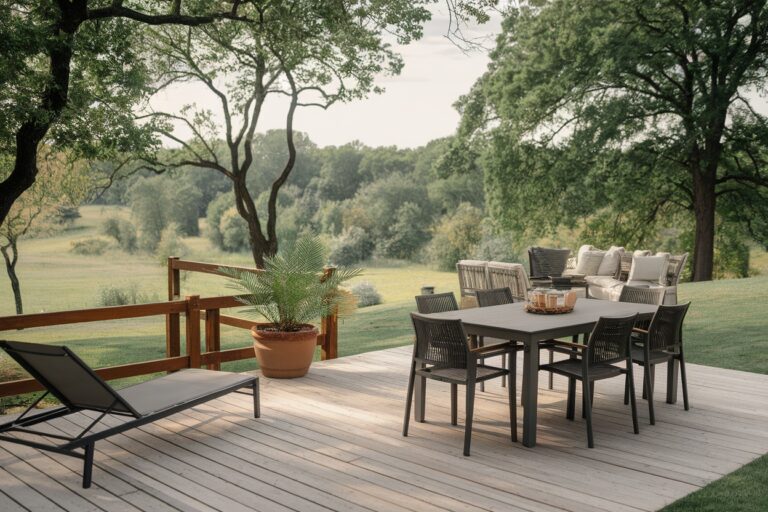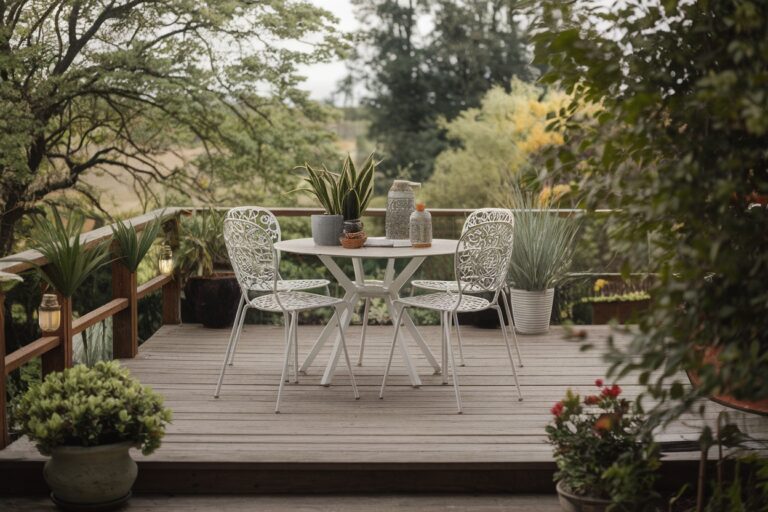12 Native Plants Perfect for a Thriving Southwestern Garden: Beautiful Choices for Low-Maintenance Landscaping
Creating a beautiful, low-maintenance southwest garden really starts with picking the right plants. Native plants just handle the hot, dry climate of the American Southwest better than most, and your garden will thank you for it.
They support local wildlife, look great all year, and usually shrug off pests and diseases.

These 12 native plants bring color, texture, and some real personality to any southwest garden. From striking cacti and bold yuccas to hardy shrubs and cheerful wildflowers, they just seem to thrive where others give up.
Learning about these top picks makes designing a garden that’s easy to care for and packed with interest a whole lot simpler.
Choosing the right plants can completely change any outdoor space. Want something vibrant and sustainable? Check out which southwest native plants might make your garden both beautiful and practical.
Why Choose Native Plants for Southwestern Gardens
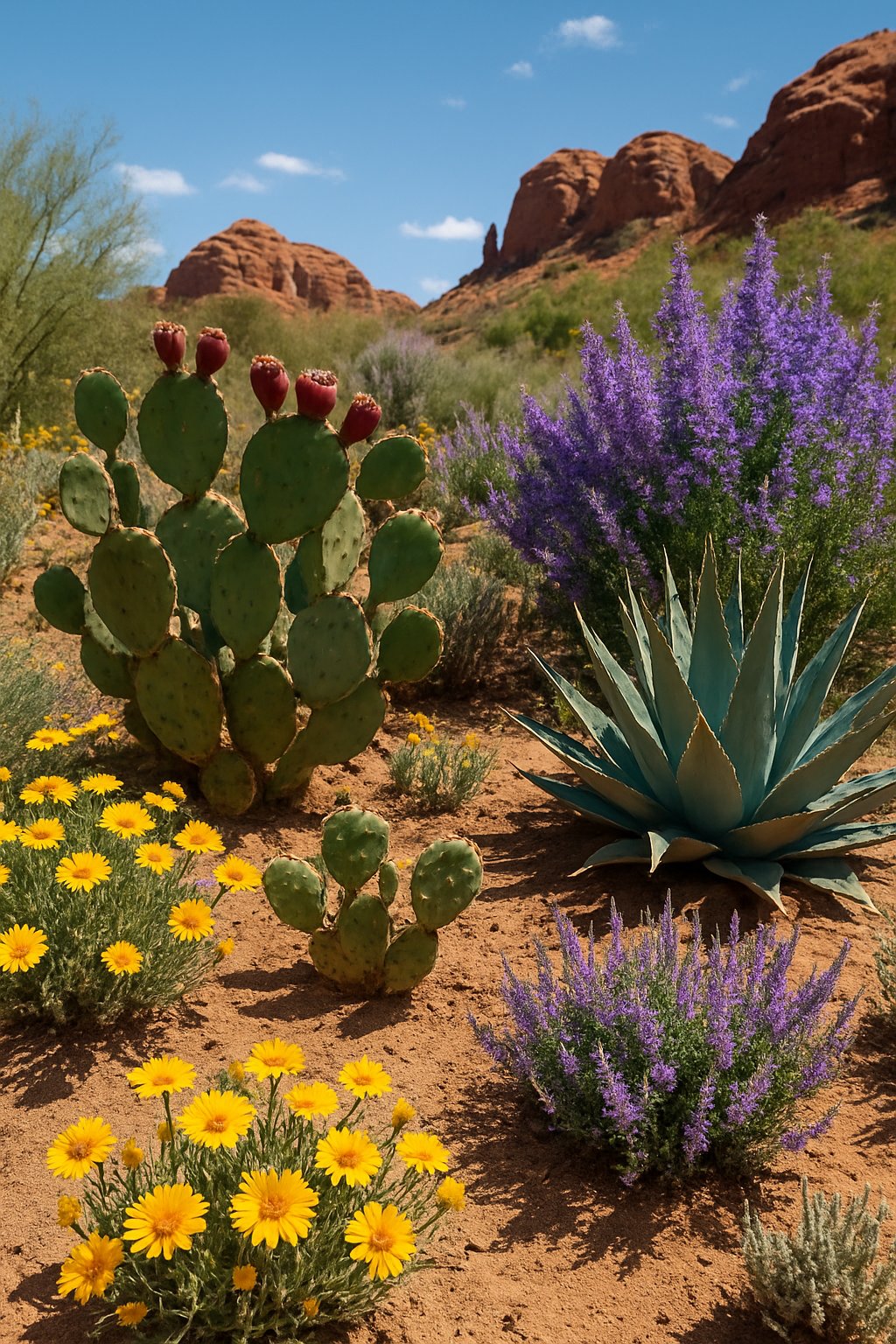
Native plants just fit the tough conditions in the Southwest. They support local animals, use less water, and keep gardens healthy by working with the natural balance of the ecosystem.
Adaptation to Dry Climate
Arizona, New Mexico, and their neighbors see plenty of heat and not much rain. Native plants have figured out how to deal with this—they grow deep roots, sport waxy leaves, and keep their leaf surfaces small to hang onto water.
They thrive while non-native plants often wilt and die.
Agave and yucca might go dormant during droughts. Desert marigold and penstemon seem to burst into bloom after a rain.
Hummingbirds and bees rely on these plants for food and shelter. Picking adapted plants keeps your garden lively even when the weather gets brutal.
Biodiversity Benefits
When you fill your garden with native species, you invite more life in. Native flowers pull in butterflies, bees, and birds—critters that count on these plants for food and nesting.
Birds snack on seeds from blue grama grass, and small mammals hide out among prickly pear pads.
Mixing up your plant choices brings more wildlife, balances the ecosystem, and helps keep pests in check.
Native roots also add structure and nutrients to the soil, which keeps things healthy underneath the surface.
Local insects have adapted to feed on these plants, so native gardens tend to resist pests naturally. That means you can skip the chemical pesticides most of the time.
Curious about these biodiversity benefits? There’s more to read if you want to dig deeper.
Water Conservation Advantages
The Southwest deals with water shortages and droughts all the time. Native plants usually get by on much less water than their imported cousins.
Homeowners can cut down on water use and bills just by choosing plants that evolved in this climate.
Desert willow and blackfoot daisy are drought-resistant, and their roots hold the soil in place, fighting erosion and runoff.
Because these plants thrive on rain alone, you can spend less time watering and more time enjoying your yard.
If you’re curious about saving water, Southwest native plants have plenty of info.
Selecting the Best Native Plants for Your Garden

Finding the right native plants isn’t just about looks. It takes a bit of research, some local advice, and paying attention to sunlight, soil, and space.
Consulting Local Extension Services and Nurseries
Local extension services and nurseries know which native plants really work in your area. They can tell you which ones boost soil health or draw in helpful wildlife.
Staff often share plant lists, growing tips, and advice about common pests or diseases.
Extension offices usually have fact sheets or databases just for the Southwest. Ask for suggestions based on your garden’s size and soil.
Good nurseries stock healthy native seeds and starters that are already adapted to the region. Sometimes they even offer garden designs for full sun or shade.
When you visit a local nursery, you get to see and touch the plants before you buy. Staff can help with questions about watering, spacing, and care.
For more tips, Garden Insider’s native plant guide is worth a look.
Considering Sun, Soil, and Space Requirements
Each native plant has its own likes and dislikes when it comes to sun, soil, and room to spread out. Watch how much sun your garden gets—some plants like little bluestem and sage want full sun, others prefer a bit of shade.
Grouping plants by their light needs just makes sense.
Soil matters, too. A lot of Southwestern natives thrive in sandy, rocky, or dry soils. If your dirt drains poorly, you might need to add compost or pick plants that don’t mind.
Plants that hate clay or soggy spots won’t do well, no matter how much you want them to.
Spacing is a big deal. Crowded plants can get sick or block each other’s light.
Check plant tags or ask nursery staff about how much room each plant needs. Planning ahead keeps your garden healthy and happy.
For more detailed ideas, Garden for Wildlife’s guide is a solid resource.
12 Native Plants Perfect for a Thriving Southwestern Garden
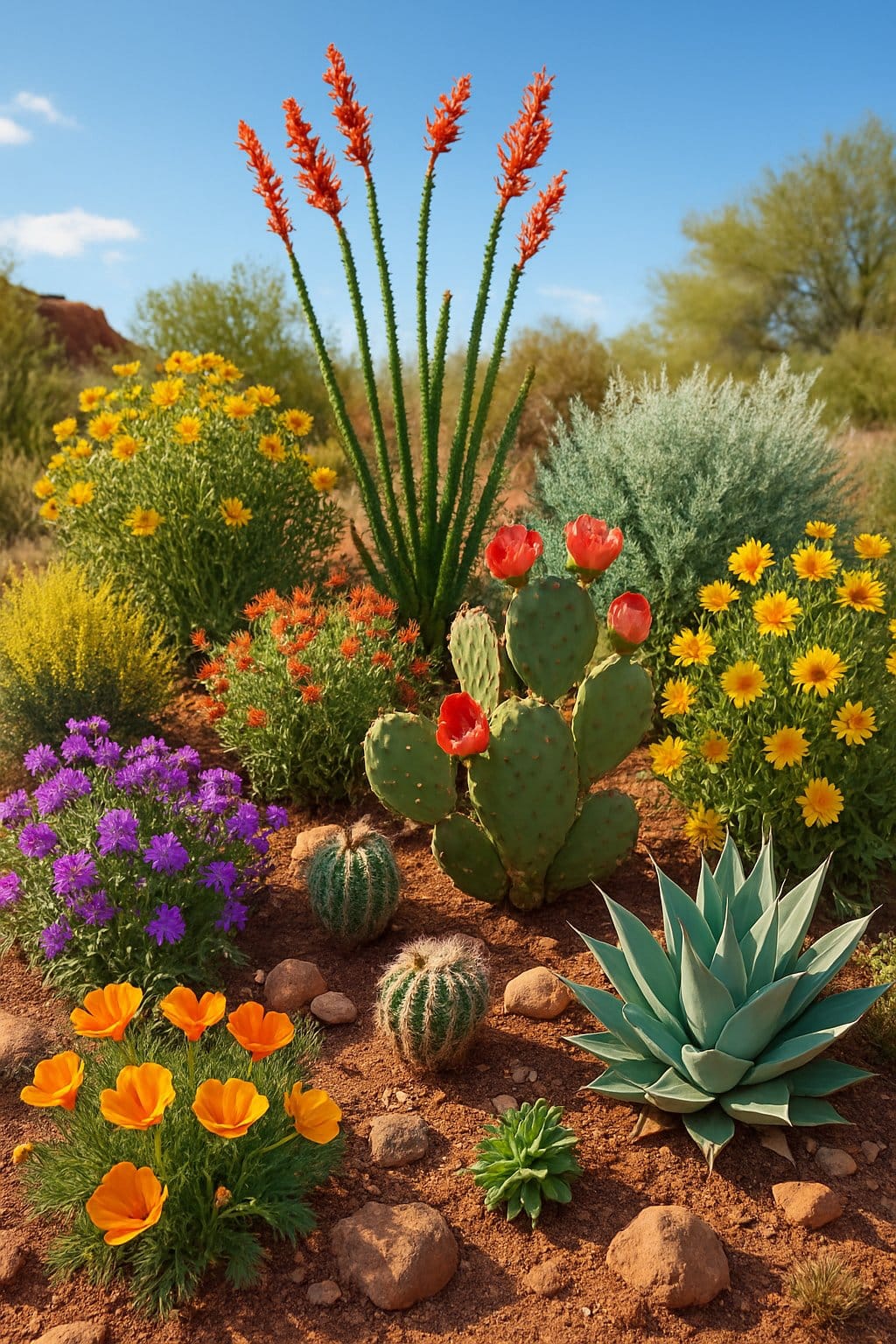
Southwestern gardens do best with tough plants that shrug off dry spells and intense sun. Penstemon, red yucca, prickly pear, and blanket flower bring color, texture, and a boost for pollinators and wildlife.
Penstemon: Vibrant Blooms for Pollinators
Penstemon—or beardtongue, as some call it—gets a lot of love for its bright, tubular flowers. You’ll find them in red, pink, purple, and blue, and they’re a magnet for hummingbirds, bees, and butterflies.
Penstemon prefers well-drained soil and full sun. Once it settles in, it barely needs water, making it a smart pick for low-water gardens.
Some types bloom from spring through early summer, so you get color for weeks.
Gardeners like mixing penstemon with bee balm or creosote bush. Its upright stems rarely flop over, and pests tend to leave it alone.
If you want more blooms, snip off faded flowers during the season.
Red Yucca: Drought-Tolerant and Striking
Red yucca isn’t a true yucca, but it sure looks the part. Those long, arching leaves and tall spikes of red or coral-pink flowers make a statement in any xeriscape.
It loves rocky or sandy soils and full sun. Water requirements? Pretty minimal.
Red yucca’s flowers draw in hummingbirds and bees, which is always a plus.
The plant rarely gets sick or bothered by pests. Native plant fans in the Southwest love it for its toughness and the fact that it just keeps its color all year.
Prickly Pear: Iconic Cactus Beauty
You can’t miss prickly pear cactus in a Southwestern landscape. Its flat, rounded pads and showy yellow or pink flowers are eye-catching, and the “tunas”—its fruit—are edible for both people and wildlife.
Prickly pear thrives in dry, sunny locations and deals just fine with rocky, poor soils.
It goes weeks without water, provides shelter and food for birds and small critters, and helps pollinators.
Adding prickly pear gives your garden that real Southwest vibe. It’s tough enough to last through years of drought.
Prickly pear pairs nicely with other native plants like creosote bush or red yucca.
Blanket Flower: Colorful and Resilient
Blanket flower (Gaillardia) is a tough native with bright red and yellow, daisy-like flowers. Bees and butterflies love it, and the blooms just keep coming from late spring into fall if you deadhead regularly.
Full sun and dry, sandy soil suit it best. Deer and most bugs leave it alone, so it’s easy to grow.
Blanket flower spreads by reseeding, filling gaps with bursts of color.
Mix it with penstemon or bee balm for layers of interest and a steady nectar supply for pollinators. It’s a favorite for its long bloom season and those bold colors.
More Excellent Choices for Southwestern Gardens
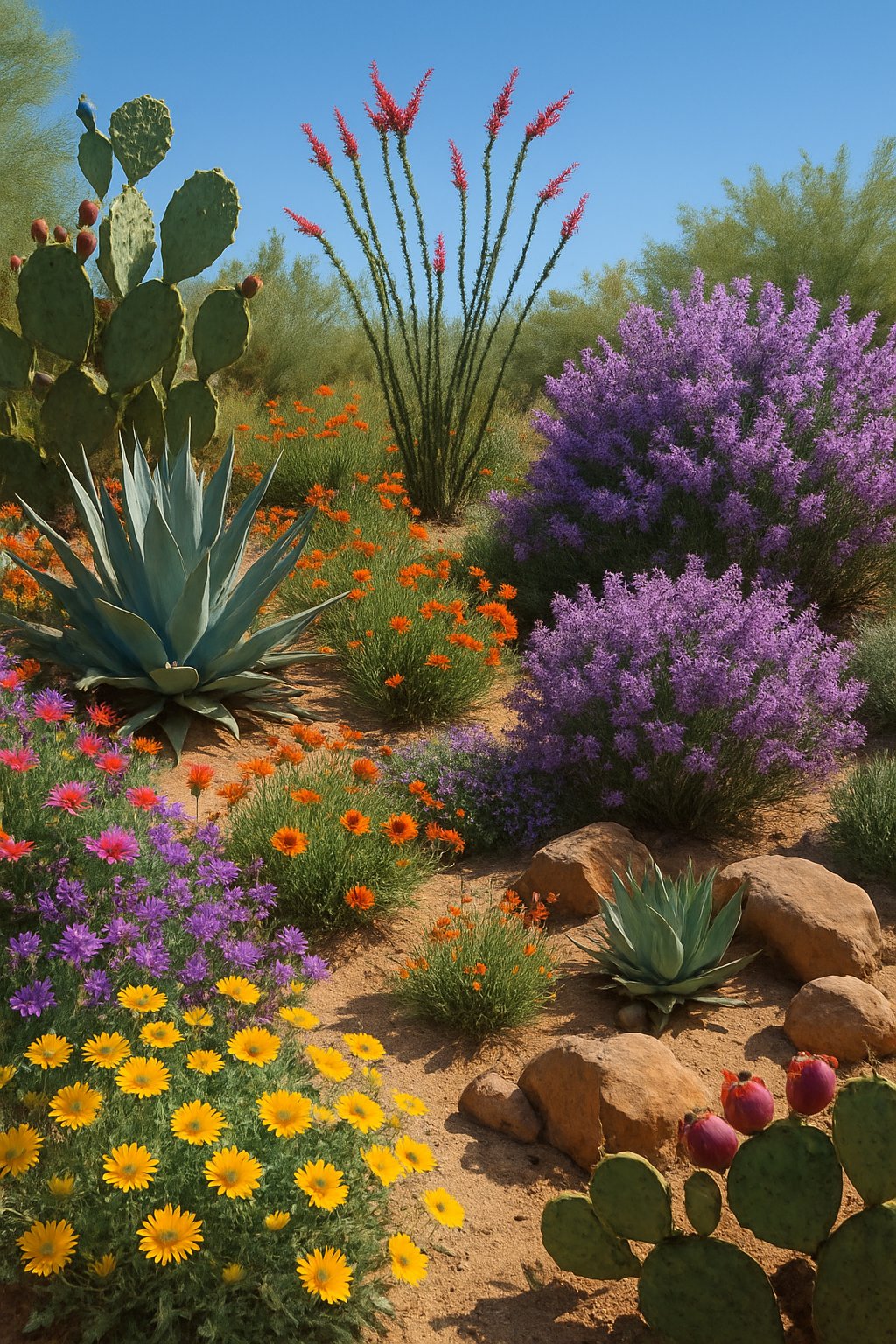
Plants like Blackfoot daisy, desert penstemon, deer grass, and yarrow handle tough conditions, look great, and support local wildlife. These drought-tolerant, easygoing natives help create a low-maintenance garden full of color and texture.
Blackfoot Daisy: Compact and Hardy
Blackfoot daisy is a real standout for hot, dry spots. It forms tidy mounds of narrow green leaves, topped with bright white flowers and sunny yellow centers.
It blooms from spring through fall, giving you color nearly all year.
Once mature, Blackfoot daisy barely needs any attention. It wants well-drained soil and full sun.
Water it occasionally and you’re set—pests usually leave it alone.
Its petite size (about 6-12 inches tall and wide) makes it great for borders and rock gardens.
Blackfoot daisy draws in butterflies and native bees, giving wildlife a boost. It doesn’t mind poor soils and doesn’t ask for much fertilizer at all.
Desert Penstemon: Attracts Hummingbirds
Hummingbirds flock to desert penstemon because of its bright, tubular flowers. The showy spikes of pink or purple blooms pop up from late winter into spring, splashing color around when most plants are still sleeping.
This perennial really prefers well-drained soils and full sun. Once it settles in, you only need to water it deeply now and then, so it’s a solid choice for water-wise gardens.
It usually grows about 1-2 feet tall and spreads to around a foot wide. Bees and butterflies visit often, too.
If you’re hoping to support pollinators without adding a ton of extra work, this plant is a gem.
Deer Grass: Graceful and Low-Maintenance
Deer grass softens up southwestern gardens with its flowing texture. Its narrow green leaves cluster tightly before sending up tall, airy flower plumes that sway with every breeze.
It can get up to 4 feet tall and just as wide, which makes it a pretty striking focal point. Once it’s established, deer grass barely needs water and thrives in full sun with well-drained soil.
This plant shrugs off drought, heat, and a bit of cold, so it’s tough as nails. Adding texture and movement to the landscape is easy with this one.
Wildlife often takes cover in deer grass, and it’s great for holding soil on slopes or open spaces. Low-maintenance fans tend to love it for its neat look and easy care.
Yarrow: Versatile and Adaptable
Yarrow really holds its own in the Southwest, thanks to strong roots and a willingness to adapt. Clusters of tiny, flat-topped flowers come in white, yellow, pink, or red from late spring through summer.
The feathery green leaves add a little extra texture. Once mature, yarrow barely needs any water and is happy in poor, rocky soils.
It works for borders, mass plantings, or as a ground cover. Full sun? Poor soil? No problem—plus, deer usually leave it alone.
Bees and butterflies are always stopping by for the blooms. Yarrow also works in cut flower arrangements, so if you want something colorful and sturdy that doesn’t ask for much, it’s a great pick.
Shrubs, Trees, and Cacti for Year-Round Interest
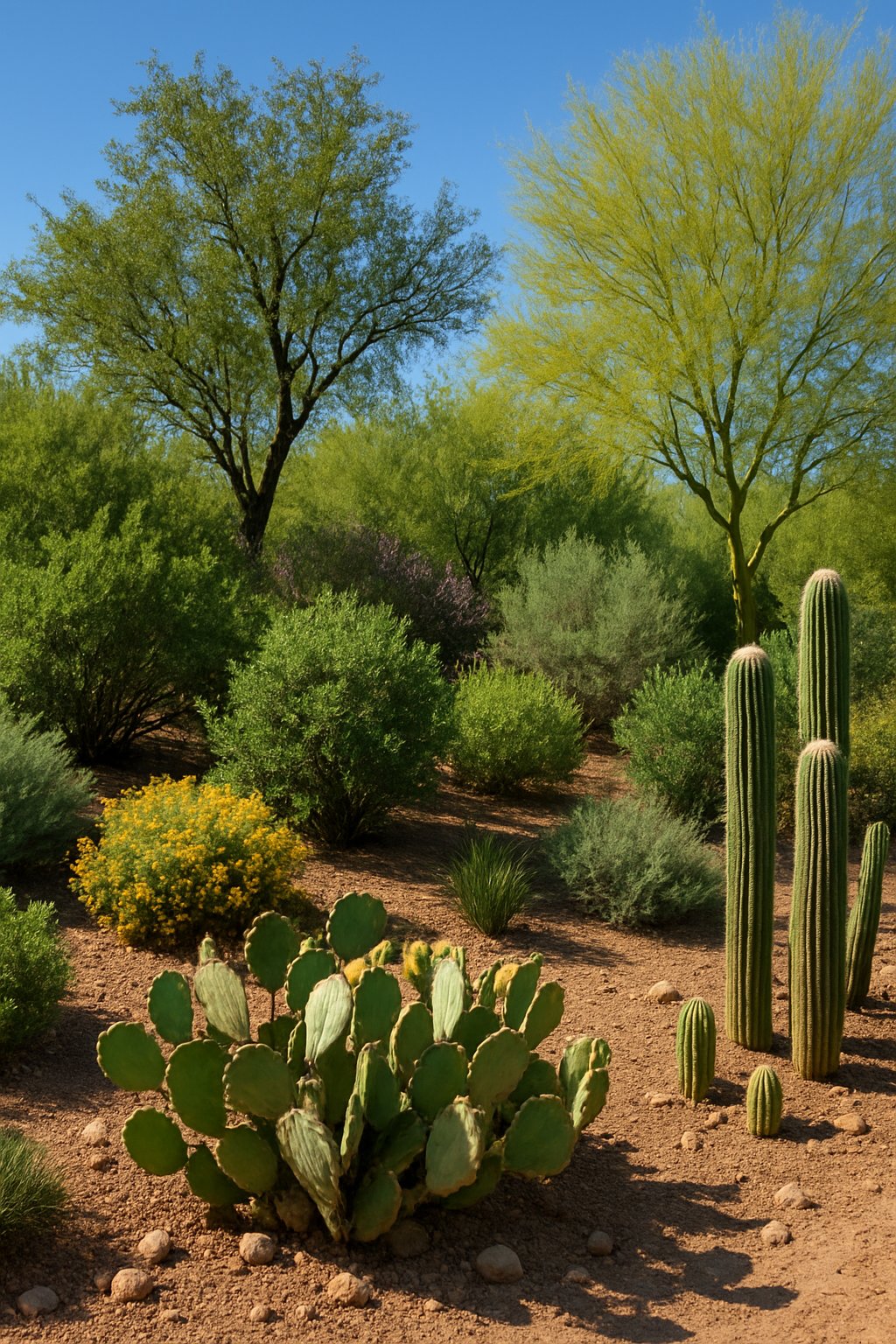
Southwestern gardens need plants that keep things interesting no matter the season. Native shrubs, trees, and cacti bring color, structure, and those cool, unique shapes—even when the sun’s relentless and the air’s bone-dry.
Chihuahuan and Creosote Bush: Foundation Shrubs
The Chihuahuan Desert shrub and creosote bush give gardens a solid base layer. Chihuahuan shrubs show off dense green foliage and small yellow blooms in spring, while their deep roots help them outlast drought.
Creosote bush stands apart with aromatic leaves and an ability to thrive in rocky, poor soils. It stays evergreen through most mild winters, holding the garden’s structure together.
Gardeners like the creosote bush for its low water needs and resilience. It’s a favorite shelter for lizards and insects, too.
Creosote fits well as a border or in the back of a bed, thanks to its upright form and tidy vibe.
Century Plant and Agave: Bold Architectural Accents
Century plant (Agave americana) and its agave relatives bring a sculptural, dramatic flair to Southwestern gardens. Thick, fleshy leaves form big rosettes in blue, gray, or green, with spiky edges that demand attention.
The century plant sometimes waits decades to bloom, then shoots up a huge flower stalk before the main rosette dies. After that, smaller rosettes, or pups, keep popping up around it.
Agaves thrive in well-drained soil and lots of sun. They’re right at home in low-water gardens and look great with cacti like saguaro.
Deer and rabbits usually steer clear, so agaves give you toughness and beauty without much fuss.
Pinyon Pine and Manzanita: Evergreen Structure
Pinyon pine and manzanita both bring year-round greenery and structure to southwestern yards. Pinyon pine stays on the small side, rarely topping 20 feet, and its short, stiff needles stay green all year.
It handles rocky, dry soils and offers food for wildlife—especially those tasty pine nuts. Manzanita stands out with smooth, reddish bark and twisting branches.
Its evergreen leaves and clusters of pink or white flowers brighten up winter and spring. Both trees grow slowly but stick around for ages.
They really prefer full sun and only need a little extra water after they’re established. Their drought tolerance and bold looks make them reliable anchors for gardens, keeping things lively through the hottest summers and surprisingly chilly winters.
Want more ideas? Check out this list of evergreen shrubs for lasting color and texture.
Supporting Pollinators and Local Wildlife
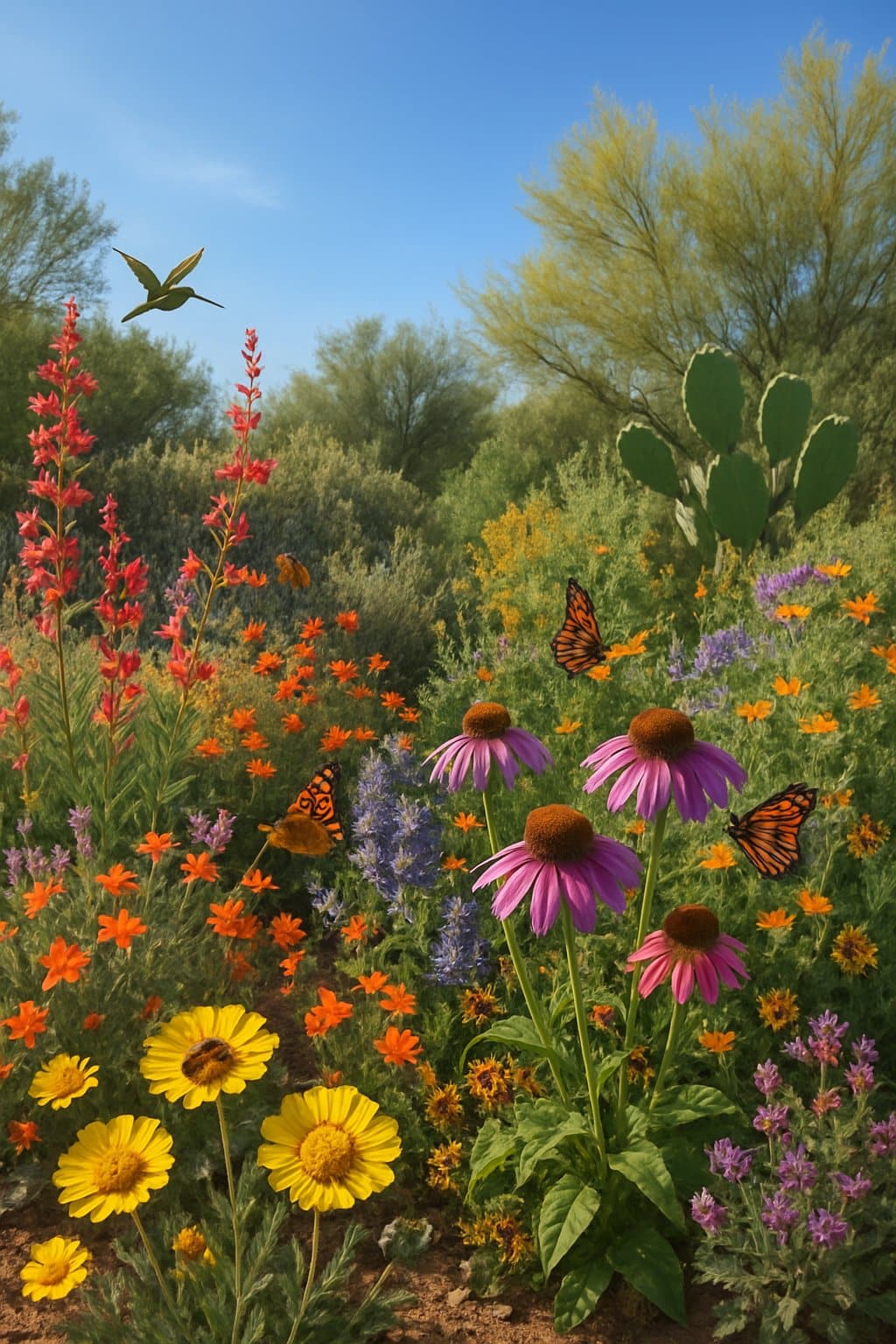
Native plants do a lot for hummingbirds, butterflies, and other pollinators. When you pick the right ones, you’ll end up supporting local birds and insects—and, honestly, your garden just buzzes with more life.
Plants for Hummingbirds
Hummingbirds go wild for bright, tubular flowers. These blooms make it easy for them to sip nectar.
Penstemon and Desert Honeysuckle are top choices, offering vivid red or orange blooms that hummingbirds can’t resist.
Desert Willow is another Southwest staple. Its pink or purple flowers are a magnet for hummingbirds, especially when natural nectar sources are running low.
Want more ideas? Here’s a list of plants that support local wildlife and pollinators.
A quick table of hummingbird-friendly native plants:
| Plant Name | Bloom Color | Bloom Season |
|---|---|---|
| Penstemon | Red, Pink | Spring-Summer |
| Desert Honeysuckle | Orange | Spring-Fall |
| Desert Willow | Pink, Purple | Late Spring-Summer |
Mixing a few of these into your garden should bring in plenty of hummingbirds.
Butterfly-Attracting Flowers
Butterflies need flowers for nectar and host plants for their caterpillars. Butterfly weed and milkweed are two of the best—bright orange and yellow blooms for nectar, and milkweed leaves as food for Monarch caterpillars.
Other native flowers, like Blackfoot Daisy and Blanket Flower, attract a wide range of butterflies. Picking a mix of colors and shapes helps bring in more species.
If you want butterflies visiting from spring through fall, just keep those blooms coming. Planting clumps of butterfly-friendly natives makes it easier for butterflies to find what they need.
Curious about creating a wildlife-friendly garden? There’s plenty of info out there.
Boosting Local Biodiversity
Native plants really ramp up biodiversity by offering shelter, nesting spots, and food for local species. Birds, bees, small mammals, and even reptiles benefit from a mix of regional plants.
Since native plants evolved alongside local wildlife, they’re just better at meeting their needs. A blend of flowers, shrubs, and groundcovers creates layers that support life at every level.
More diverse plantings mean more pollinators, birds, and animals can thrive. Want to dig deeper? See how native plants create habitats for wildlife.
Adding water, shelter, and food with local plants helps native wildlife survive droughts and other rough patches. Even a tiny garden can make a difference for the whole ecosystem.
Planting and Caring for Native Plants

Southwestern natives are tough, but a little planning and some steady care will get them off to a strong start. Good planting habits, smart watering, and a bit of maintenance make all the difference—especially when the weather’s hot and dry.
Best Planting Practices
Picking the right spot matters. Most native plants crave full sun, so aim for at least six hours of direct sunlight each day.
Check your soil—some natives like sandy, rocky ground, while others can handle clay. For best results, plant during fall or early spring, when it’s cooler.
That way, roots get a head start before summer heat kicks in. Dig a hole as deep as the root ball and twice as wide, then gently loosen the roots before setting the plant.
Grouping plants with similar water and sunlight needs makes care way easier. Don’t crowd them, but plant so leaves will touch as they mature—this shades the soil and helps keep moisture in.
Need help planning? Here’s a guide to site preparation and design.
Mulching, Watering, and Fertilization
Mulching is a lifesaver in dry regions. A two-to-three-inch layer of natural mulch—like wood chips, bark, or gravel—keeps soil cool and protects roots.
It also helps hold in moisture, cuts down on weeds, and slowly improves your soil. When watering, remember these plants are used to dry spells.
Water deeply but less often, especially after the first year. The first season is key—keep soil moist but not soggy while roots settle in.
Most southwestern natives don’t need much fertilizer. Skip the synthetic stuff; it can actually harm the soil and stress your plants.
If your soil is really poor, a little well-aged compost is usually enough. Want more tips? Check this native plant gardening guide.
Pruning and Seasonal Maintenance
Regular pruning encourages bushier growth and gets rid of damaged or diseased stems. Prune perennials in late winter or early spring before new growth starts.
This keeps things tidy and can boost blooms. Shrubs might need a quick trim after flowering to stay in shape.
Seasonal maintenance isn’t complicated. Remove dead leaves or flowers to cut down on pests and disease.
Keep an eye out for stress—wilting or yellow leaves usually mean it’s time to adjust water. Native gardens also benefit from an annual weed check.
Pulling weeds when the soil’s damp makes it way easier. Here’s a handy maintenance guide if you want more details.
Design Tips for a Beautiful and Sustainable Garden
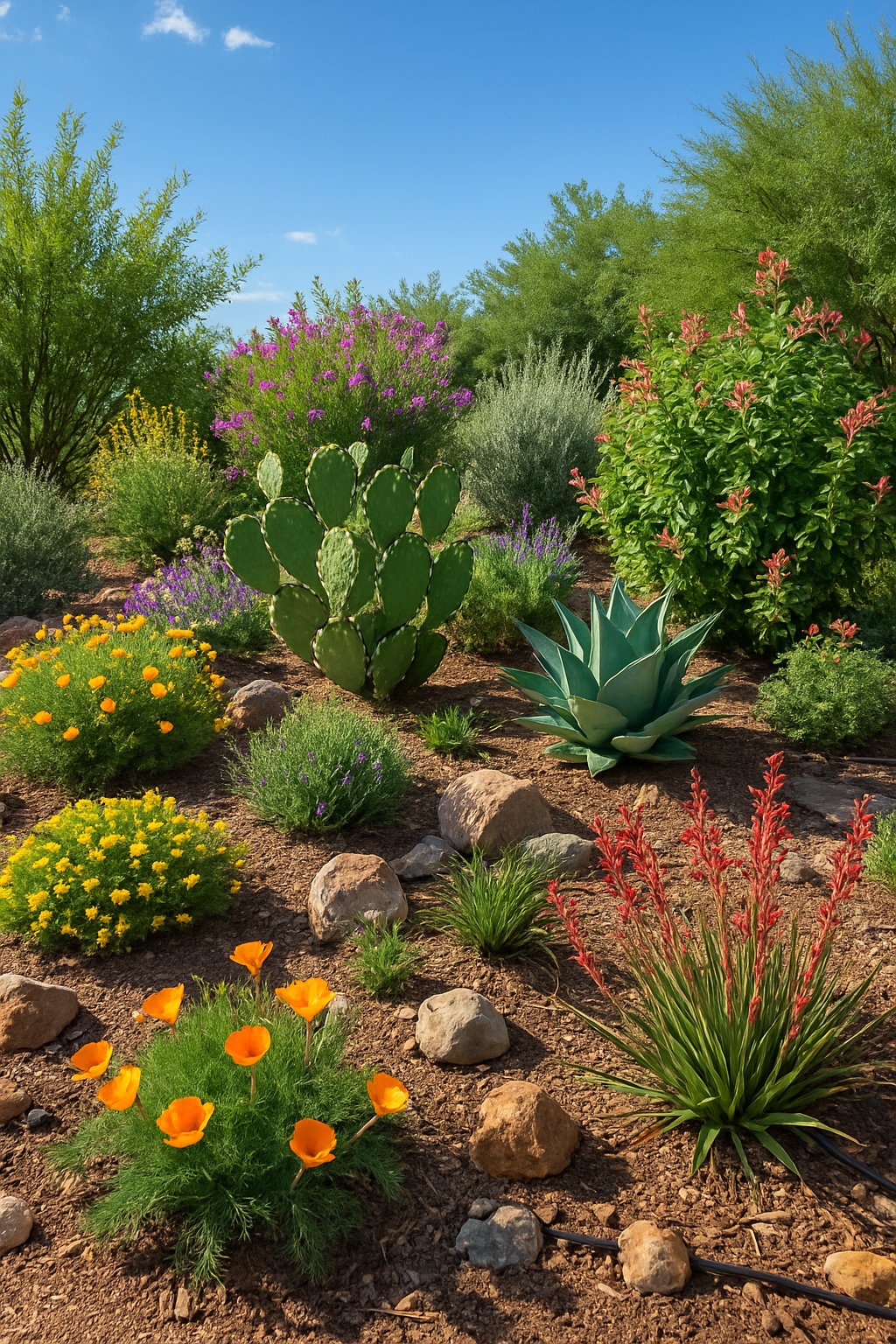
Getting the layout right lets your southwest garden shine while saving water. Smart plant choices and a thoughtful design can highlight the color and rugged charm of a desert landscape—no need to waste resources.
Arranging Garden Beds for Visual Impact
Layering plants by height makes even small spaces feel bigger. Put tall native grasses or shrubs like sotol at the back or center, and let groundcovers fill in the edges.
Mirroring the patterns you see out in the wild Southwest gives gardens a relaxed, natural vibe. Grouping plants with similar water needs in the same bed just makes sense for water conservation.
This approach helps avoid overwatering and keeps everything healthy. Repeating a few plant types throughout the garden ties the whole space together.
Color matters, too. Mixing plants with different bloom times from spring through fall keeps things lively.
If you’re a planner, charting out peak color for each plant on a calendar or table can really help.
Incorporating Rocks and Hardscape Elements
Rocks and stone paths really fit the desert landscape—they break up planting areas and add a sense of rhythm. When you use gravel, flagstone, or boulders, they soak up heat, which actually helps some native plants thrive.
These features tend to highlight the shapes and colors of the surrounding plants in a way that’s hard to fake. Small, dry creek beds can bring a sense of movement and even help direct rain runoff away from walkways.
If you build raised beds with natural stone, you get more structure and, honestly, maintenance feels a bit less daunting. Mulch made of gravel or pebbles keeps the soil cooler and does a decent job at holding back weeds.
Benches or rustic paths invite you to slow down and actually enjoy the garden. With a little thought, hardscape can support garden designs that not only look great but also stand up to the tough Southwest climate.




